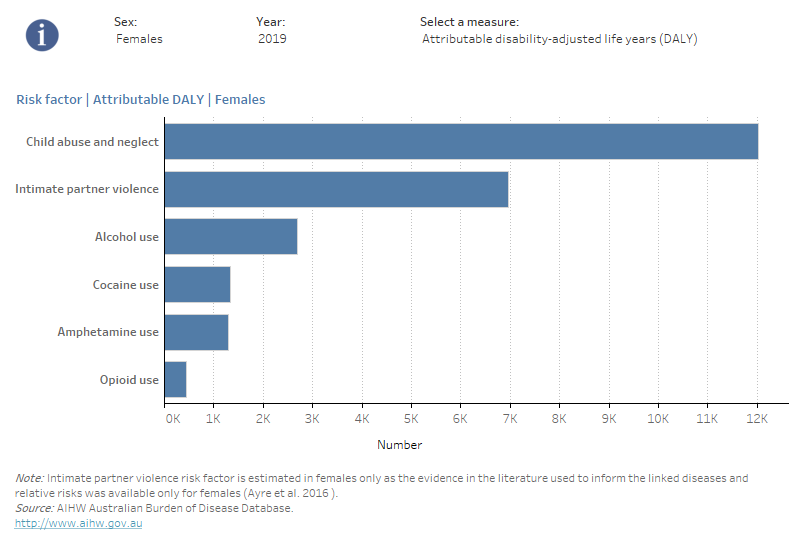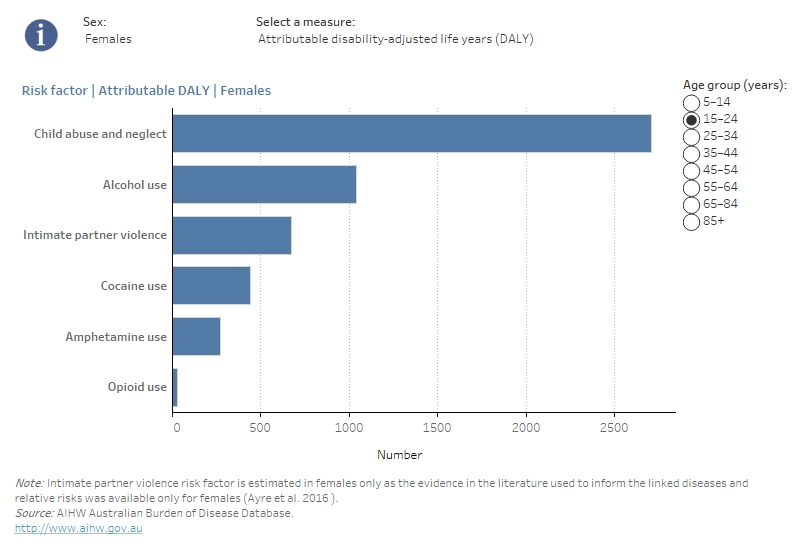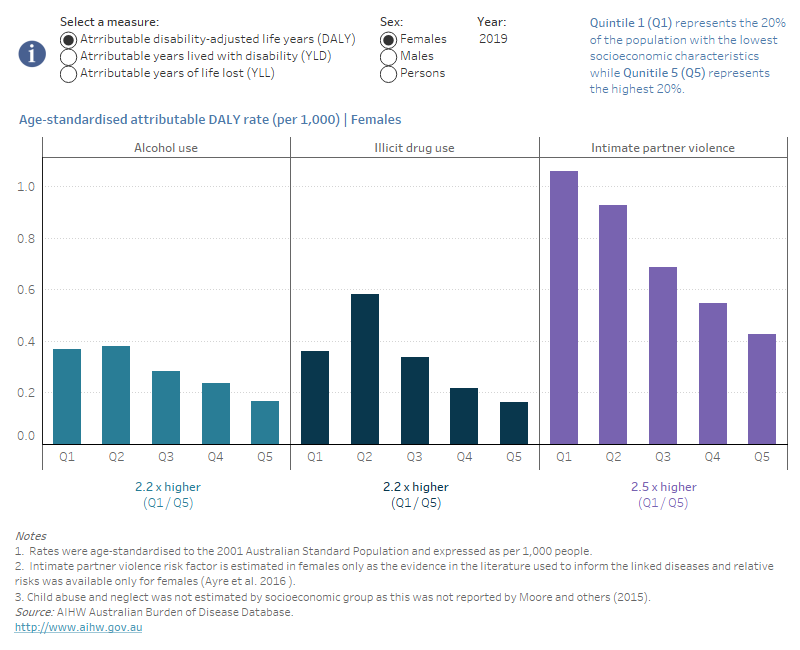Risk factors
Box 2: How are risk factors selected?
A portion of disease burden could be prevented if exposure to relevant risk factors were avoided or reduced. The 2018 ABDS examined the contribution of 40 risk factor exposures (such as cannabis use, cocaine use) combined into 20 individual risk factors (such as illicit drug use) to the burden of disease (referred to as ‘attributable burden’). Attributable burden reflects the direct link between a risk factor (for example, alcohol use) and a disease or injury outcome (for example, suicide and self-inflicted injury).
For a risk factor to be included in the study, it had to meet several criteria including:
- having strong evidence of a causal association with linked diseases measured in the ABDSs
- being modifiable
- being able to be measured in the Australian population (AIHW forthcoming 2021b).
Associations between risk factors and linked diseases were evaluated based on sufficient evidence of a causal link. These were assessed against criteria established by the World Cancer Research Fund whose grading system evaluates associations as being either convincing, probable, possible or insufficient.
Four individual risk factors (6 risk factor exposures) were included in the analysis of attributable burden for suicide and self-inflicted injuries as having convincing or probable evidence in the literature of a causal association (AIHW 2018; Ayre et al. 2016; Moore et al. 2015):
- child abuse and neglect during childhood among people aged 5 and over
- alcohol use among people aged 15 and over
- illicit drug use (specifically, amphetamine use, cocaine use, and opioid use) among people aged 15 and over
- intimate partner violence among women aged 15 and over. The contribution of these risk factors to the burden of suicide and self-inflicted injuries is now described.
In 2019, it is estimated that almost half (48%) of the burden of suicide and self-inflicted injuries is due to these 4 modifiable risk factors.
Child abuse and neglect during childhood was consistently the leading behavioural risk factor contributing to the burden of suicide and self-inflicted injuries in both males and females aged 5 and over between 2003 and 2019 (Figure 11). In 2019, it contributed one‑third (33%; 12,031 DALY) of the total burden in females and 24% in males (25,690 DALY) (Table S11).
Figure 11: Burden of suicide and self-inflicted injuries attributable to selected risk factors, by sex, 2003, 2011, 2015, 2018 and 2019
This bar chart presents numbers and proportions of burden of suicide and self-inflicted injuries due to six risk factor exposures by sex in 2003, 2011, 2015, 2018 and 2019. These risk factors are child abuse and neglect during childhood among people aged 5 years and over; alcohol use and illicit drug use (specifically cocaine use, amphetamine use and opioid use) among people aged 15 years and over; and intimate partner violence among females aged 15 years and over.
It also shows the ranking of the attributable burden in the selected risk factors for each reference year. Child abuse and neglect during childhood was consistently the leading behavioural risk factor contributing to the burden of suicide and self-inflicted injuries in both males and females aged 5 years and over between 2003 and 2019. In 2019, it contributed one third (33%; 12,031 DALY) of the total burden in females and 24% in males (25,690 DALY).

Among males aged 15 and over, alcohol use was the second leading behavioural risk factor and was responsible for 17% (18,108 DALY) of the total burden of suicide in 2019. For women aged 15 and over, intimate partner violence was the second leading contributor (20%; 6,964 DALY) in 2019, and this was consistent over time.
Among those aged 15 and over, illicit drug use was responsible for 17% of male and 8.6% of female suicide burden in 2019. Cocaine use had the greatest attributable DALY, followed by amphetamine use and opioid use.
In 2019, child abuse and neglect during childhood was the greatest contributor to the total burden of suicide and self-inflicted injuries in both males and females aged 5 and over in all age groups except women aged 85 and over (Table S12). The majority of the burden attributable to child abuse and neglect was experienced in ages 15–44.
The majority of the burden of suicide and self-inflicted injuries attributable to alcohol use occurred in those aged 15–54, peaking at 15–24 for both males and females. Similarly, most of the burden attributable to illicit drug use was experienced in those aged 15–54, peaking at 25–34 for both males and females (Table S12).
The risk factors contributing to the burden of suicide and self-inflicted injuries varied somewhat by age group.
- For example, for children aged 5–14, child abuse and neglect is the only risk factor contributing to the burden, responsible for 18% of male and 26% of female burden due to suicide and self-inflicted injuries in 2019 (Figure 12).
- Among those aged 65–84, intimate partner violence was responsible for 18% of the female burden due to suicide and self-inflicted injuries, while child abuse and neglect was responsible for 16% of the total burden due to suicide and self-inflicted injuries in this age group.
- For women aged 85 and over, intimate partner violence was the main risk factor contributing to the burden due to suicide and self-inflicted injuries (responsible for 15%).
Figure 12: Burden of suicide and self-inflicted injuries attributable to selected risk factors, by age and sex, 2019
The bar chart presents rankings of attributable burden of suicide and self-inflected injuries of the six risk factor exposures by sex and age group. These risk factors are child abuse and neglect during childhood among people aged 5 years and over; alcohol use and illicit drug use (specifically cocaine use, amphetamine use and opioid use) among people aged 15 years and over; and intimate partner violence among females aged 15 years and over.
The risk factors contributing to the burden of suicide and self-inflicted injuries varied somewhat by age group. For example, for those aged 5-14, child abuse and neglect is the only risk factor contributing burden, responsible for 18% of male and 26% of female burden due to suicide and self-inflicted injuries in 2019. For those aged 65-84 years, intimate partner violence and child abuse and neglect were the major risk factors contributing burden (responsible for 18% and 16% respectively); and for women aged 85 years and over, intimate partner violence was the main risk factor contributing to the burden due to suicide and self-inflicted injuries (responsible for 15%).

It is not possible to estimate attributable burden for child abuse and neglect in childhood by socioeconomic area as Moore and others (2015) did not report this. For the other risk factors, there was a general pattern of increasing attributable burden with decreasing socioeconomic position, after adjusting for population increase and ageing.
For example, in 2019, the rates of suicide burden attributable to alcohol use were 2.8 times higher for males and 2.2 times higher for females in the lowest socioeconomic areas (most disadvantage areas) compared with the highest (least disadvantaged) areas (Figure 13; Table S13). For illicit drug use among both males and females, the attributable burden was highest in the second most disadvantaged areas (Quintile 2, or Q2) and lowest in the least disadvantaged areas (Quintile 5, or Q5), with the greatest disparity seen for opioid use (Table S13).
Figure 13: Burden (DALY, YLL and YLD) of suicide and self-inflicted injuries attributable to selected risk factors, by socioeconomic area and sex, 2019
The grouped bar chart presents the burden of suicide and self-inflicted injuries attributable to three selected risk factors (alcohol use and illicit drug use among people aged 15 years and over; and intimate partner violence among females aged 15 years and over) by socioeconomic area and sex in 2015, 2018 and 2019.
The figure shows the distribution and ratio between the age-standardised attributable rate in the lowest socioeconomic area to those in the highest area for each of the three risk factors by reference year and sex, for 2015, 2018 and 2019. For example, in 2019 the age-standardised rates of suicide burden attributable to alcohol use were 2.8 times higher for males and 2.2 times higher for females in the lowest socioeconomic area compared to the highest area.



